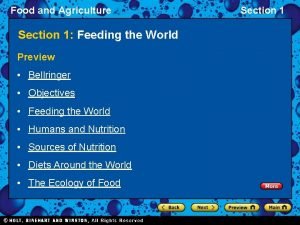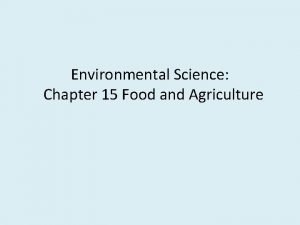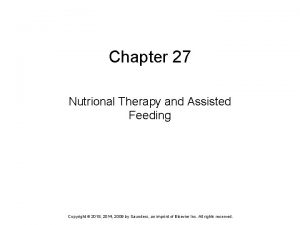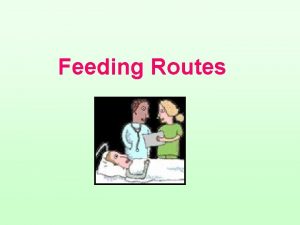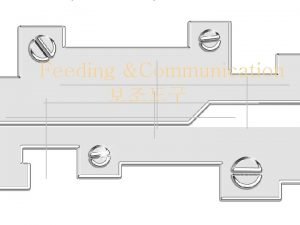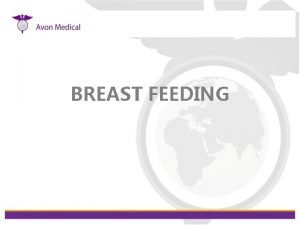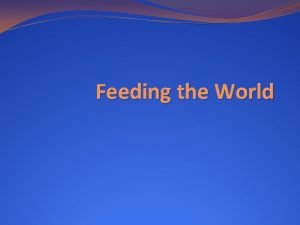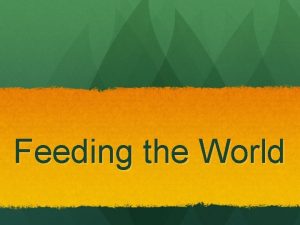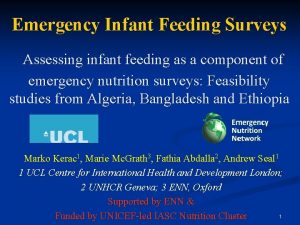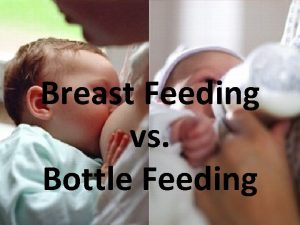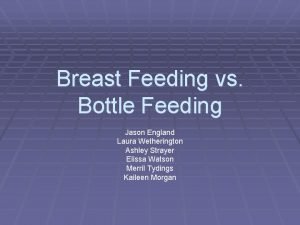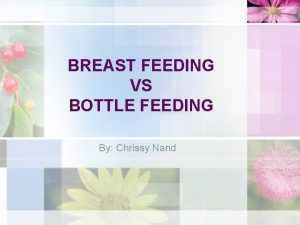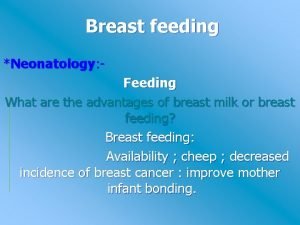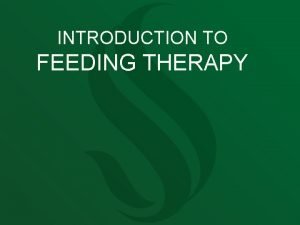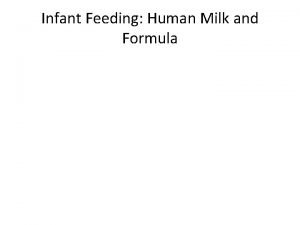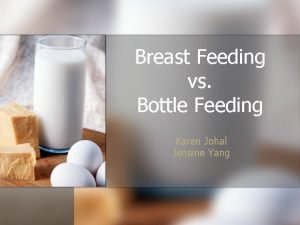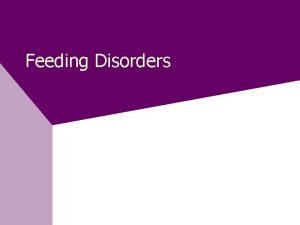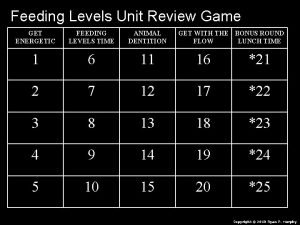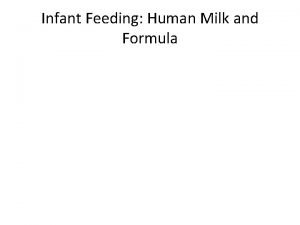Chapter 11 Feeding the World Feeding the World






























- Slides: 30

Chapter 11 Feeding the World

Feeding the World Think & Write Why do you think it is so difficult to provide adequate food for all of the world’s people? What are some limitations? What can be done to increase production? How do farmers keep insects from destroying crops? What are some alternatives to chemical pesticides?

A Balanced Diet vs. malnutrition Nutrient e d e ot ne NFunction s e t o d in n Major Food Sources Carbohydrates Supplies Energy Bread, Cereals, Potatoes, Beans Proteins Used to build and maintain the body Meat, Fish, Poultry, Eggs, Dairy, Beans Lipids (fats and solids) Used to build membranes and some hormones. May help store energy. Butter, Vegetable Oils, Animal Fats

Nutritional Requirements Overnutrition Over Undernutrition Under Malnourished Mal too many calories and improper foods that causes a person to become overweight. not consuming enough calories to be healthy. a persons diet lacks the correct balance of proteins, carbohydrates, vitamins, and minerals even though they get enough calories. Related terms: • Food Insecurity • Famine • Anemia Global Nutrition Imbalance

Global Undernutrition

Reasons for Undernutrition and Malnutrition Ø Economy – Poverty vs. Wealthy Ø Society – influenced by media Ø Political factors (war, genocide, etc. ) Ø Agricultural resources being diverted to feed livestock (and make ethanol-fuel) rather than people

Annual Meat Consumption Interpreting Graphs: ese h t r e ur Answ o y n i ns o i t s e qu oks o b e t no 1) How does the United States compare to the rest of the world in terms of meat consumption? 2) What are some issues regarding agriculture (or environmental effects) of eating more meat? (feel free to search online)

Global Grain Production, 1950 -2006 Interpreting Graphs: se e h t r Answe in your s n o i t s que ks o o b e not 3) Why does lower graph (b) appear to remain level while the upper graph (a) is increasing? 4) What do you think are primary types of “grain” from various parts of the world? • Asia • Africa • Central America • North America

Agricultural Revolutions Since the Industrial Revolution in the 1800’s, agriculture became more “industrialized”, burning fossil fuels to replace human & animal labor. The “Green” Revolution: Between the 1950’s - 1970’s: new management techniques and mechanization as well as the triad of fertilization, irrigation, and improved crop varieties increased food production dramatically. Pros The introduction of new grains and new farming techniques allowed for a much greater “yield”. Cons New varieties require more fertilizer, pesticides, and water.

Some people speak of agriculture collectively as “the single most harmful human action that has taken place. ” - Friedland p. 287 Irrigation Biological Genetic Chemical Soil Conservation Pest Control Industrial vs Sustainabl e Erosion Desertification Salinization Fertilizer Climate Seasonal Changes Air Pollution Floods/Drought

Issues: Arable Land (suitable for farming) decreased 1/5 from 1985 to 2000. Over ½ of the fertile “Top. Soil” has been lost in the U. S. just in the past 200 years due to erosion: the wearing away of erosion topsoil by wind and water. Effects: Desertification: areas where Desertification topsoil is easily destroyed, and the land becomes desert-like. Soil can be degraded by agriculture to the point at which it is no longer productive. Salinization: When small Salinization amounts of salts in irrigation water accumulate and become highly concentrated in the soil. Solutions: Contour plowing: plowing following the terrain prevents erosion. No-till farming: leaving farming the remain of previous crops to decompose and retain soil. Low-input farming: farming using as little fertilizer, pesticide, energy and water as possible. Composting!

Irrigation Problems o o o Waterlogging- when the soil remains under water for prolonged periods which impairs root growth because the roots cannot get oxygen. Salinization- when the small amounts of salts in irrigation water become highly concentrated on the soil surface through evaporation. And, of course, DROUGHT!

Desertification Desertification- When soil is degraded by agriculture to the point at which they are no longer productive.

Fertilizers Organic fertilizers- organic matter from plants and animals. Typically made from animal manure that has been allowed to decompose. Inorganic fertilizers (synthetic)- fertilizers that are produced commercially. This is usually done by combusting natural gas, which allows nitrogen from the atmosphere to be “fixed” and captured in fertilizer. Remember “nitrogen fixation”?

Monocropping Growing a large amount of a single species of plant. Advantages: Advantages allows large expanses of land to be planted, and then harvested, all at the same time. v Disadvantages: Disadvantages • When monocropped fields are readied for planting or harvesting all at once, soil will be exposed over many hectares at the same time. • Some farmland in the United States loses an average of 1 metric ton of topsoil per hectare/year to wind erosion. • Pests easily invade monocrops and reproduce rapidly. • Monocropping removes habitat for predators that might otherwise control the pest population.

Pest Control Pesticides: substances that kill pests. Solutions: Solutions Biological Pest Control Issues: Issues Beneficial Organisms Pathogens suffer from chemicals, too. Humans have also suffered cancer and illness due to exposure to pesticides. Many pesticides are persistent (do not break down into harmless chemicals when they enter the environment) and accumulate in water and soil. Plant defenses Chemicals from plants Disrupting insect breeding Organic Pest Control Companion Planting Ladybugs Soapy water

Pesticides Pesticide- a substance that kills or controls organisms that people consider pests. Related to: Insecticide- target insects Herbicides- target plants Broad-spectrum - pesticides designed to kill many different types of pests. Persistent - pesticides that do not break down and thus remain in the environment, accumulating in water and soil. Selective – pesticides . designed to kill a narrower range of organisms. vs Non-persistent - pesticides . that breaks down relatively rapidly, usually in weeks to months. vs

Pesticides Ø Bioaccumulation- some pesticides build up over time in the fatty tissues of predators. Ø An example was DDT. Ø When an organism containing the pesticide is eaten, the chemical is transferred to the consumer. Ø This eventually leads to very high pesticide concentrations at high trophic levels.

Pesticides Resistance - pest populations may evolve resistance to a pesticide over time. Pesticide treadmill - the cycle of pesticide development followed by pest resistance, requiring development of a new pesticide.

Integrated Pest Management (IPM) Integrated pest managementusing a variety of techniques designed to minimize pesticide inputs. Techniques: Crop rotation Intercropping Planting pest resistant crop varieties Creating habitats for predators Limited use of pesticides

Agricultural Effects on the Climate From Farming in general…… CO 2 releases linked to deforestation 9% of global CO 2 emissions comes from livestock Methane releases from fermenting cattle feces 35– 40% of global methane emissions Nitrous oxide releases from fertilizer application 64% of global nitrous oxide emissions

GMOs Genetically Modified Organisms

GMOs Genetically Modified Organisms CONs PROs Greater yield Environmental hazards More profit Harm to other organisms Increase nutrition Reduced effectiveness of pesticides Pest resistance Gene transfer to non-target species Herbicide tolerance Human health risks Disease resistance Unlabeled / Unregulated Cold tolerance Antibiotics lose effectiveness Drought tolerance Allergens, Carcinogens (cause cancer) Unwanted Steroids & Hormones Salinity tolerance Pharmaceuticals

GMOs Genetically Modified Organisms What are the impacts of GMOs on the environment? • More than 80% of all GMOs grown worldwide are engineered for herbicide tolerance 5. As a result, use of toxic herbicides like Roundup has increased 16 times since GMOs were introduced 6. • GM crops are also responsible for the emergence of herbicide resistant “super weeds” and “super bugs, ” which can only be killed with more toxic poisons like 2, 4 -D (a major ingredient in Agent Orange) 7, 8. • GMOs are a direct extension of chemical agriculture and are developed and sold by the world’s biggest chemical companies. • The long-term impacts of GMOs are unknown, and once released into the environment, these novel organisms cannot be recalled. https: //www. nongmoproject. org/gmo-facts/

Farming Methods Nomadic grazing - moving herds of animals to find productive feeding grounds. e c n e t s i s b “Su ” Traditional farming - still used in the developing world where human labor is used and not machinery. Conventional agriculture - “industrial agriculture” where labor is reduced and machinery is used. Shifting agriculture - used in areas with nutrient poor soils. It involves planting an area for a few years until the land is depleted of nutrients and then moving to another area and repeating the process.

High-Density Animal Farming CAFOs (concentrated animal feeding operations) - large structures or lots where animals are being raised in high density numbers. • High-density animal farming is used for beef cattle, dairy cows, hogs, and poultry, all of which are confined or allowed very little room for movement. • Animals are given antibiotics to reduce the risk of adverse health effects and diseases which would normally be high in such highly concentrated animal populations. o contributing to an increase in antibioticresistant strains of microorganisms that can affect humans.

Harvesting of Fish and Shellfish Fishery - a commercially harvestable population of fish within a particular ecological region. Bycatch - unintentional catch of non-target species. Fishery collapse - the decline of a fish population by 90% or more.

Aquaculture Aquaculture- the farming of aquatic organisms such as fish, shellfish, and seaweeds. PRO: can alleviate some of the human-caused pressure on overexploited fisheries while providing muchneeded protein for the more than 1 billion undernourished people in the world. CON: environmental problems: • wastewater containing feces, uneaten food, and antibiotics is pumped back into the river or ocean • may contain bacteria, viruses, and pests that thrive in the high-density habitat • fish that escape from aquaculture facilities spread diseases and parasites in surrounding waters.

Sustainable Agriculture Sustainable agriculture- producing enough food to feed the world’s population without destroying the land, polluting the environment, or reducing biodiversity. • Intercropping- two or more crop species are planted in the same field at the same time. • Crop rotation- rotating crops species from season to season. • Agroforestry- intercropping trees with vegetables. • Contour plowing- plowing and harvesting parallel to the land to prevent erosion. • No-till agriculture- not tilling the land after each harvest helps to stop soil degradation by leaving crop residues in the fields.

Organic Agriculture Organic agriculture- production of crops without the use of synthetic pesticides or fertilizers. Organic agriculture follows several basic principles: • Use ecological principles and work with natural systems rather than dominating them. • Keep as much organic matter and as many nutrients in the soil and on the farm as possible. • Avoid the use of synthetic fertilizers and pesticides. • Maintain the soil by increasing soil mass, biological activity, and beneficial chemical properties. • Reduce the adverse environmental effects of agriculture.
 Continuous feeding vs bolus feeding
Continuous feeding vs bolus feeding Section 1 feeding the world
Section 1 feeding the world Active reading animals and agriculture
Active reading animals and agriculture Chapter 27 nutritional therapy and assisted feeding
Chapter 27 nutritional therapy and assisted feeding Chapter 18 eating and feeding disorders
Chapter 18 eating and feeding disorders Ap world history chapter 25 africa and the atlantic world
Ap world history chapter 25 africa and the atlantic world Hình ảnh bộ gõ cơ thể búng tay
Hình ảnh bộ gõ cơ thể búng tay Ng-html
Ng-html Bổ thể
Bổ thể Tỉ lệ cơ thể trẻ em
Tỉ lệ cơ thể trẻ em Gấu đi như thế nào
Gấu đi như thế nào Chụp tư thế worms-breton
Chụp tư thế worms-breton Chúa sống lại
Chúa sống lại Môn thể thao bắt đầu bằng chữ đua
Môn thể thao bắt đầu bằng chữ đua Thế nào là hệ số cao nhất
Thế nào là hệ số cao nhất Các châu lục và đại dương trên thế giới
Các châu lục và đại dương trên thế giới Công thức tính độ biến thiên đông lượng
Công thức tính độ biến thiên đông lượng Trời xanh đây là của chúng ta thể thơ
Trời xanh đây là của chúng ta thể thơ Mật thư anh em như thể tay chân
Mật thư anh em như thể tay chân Làm thế nào để 102-1=99
Làm thế nào để 102-1=99 độ dài liên kết
độ dài liên kết Các châu lục và đại dương trên thế giới
Các châu lục và đại dương trên thế giới Thơ thất ngôn tứ tuyệt đường luật
Thơ thất ngôn tứ tuyệt đường luật Quá trình desamine hóa có thể tạo ra
Quá trình desamine hóa có thể tạo ra Một số thể thơ truyền thống
Một số thể thơ truyền thống Bàn tay mà dây bẩn
Bàn tay mà dây bẩn Vẽ hình chiếu vuông góc của vật thể sau
Vẽ hình chiếu vuông góc của vật thể sau Biện pháp chống mỏi cơ
Biện pháp chống mỏi cơ đặc điểm cơ thể của người tối cổ
đặc điểm cơ thể của người tối cổ Ví dụ giọng cùng tên
Ví dụ giọng cùng tên Vẽ hình chiếu đứng bằng cạnh của vật thể
Vẽ hình chiếu đứng bằng cạnh của vật thể

